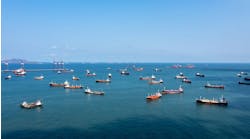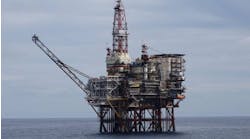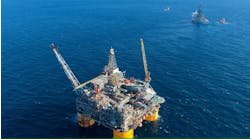Eldon Ball • Houston
It’s that time again – the annual Offshore Technology Conference in Houston.
And as the Houston event and this issue ofOffshore both reflect, the offshore oil and gas industry is in great financial health.
As the lead articles in this issue reveal, IOCs and NOCs alike have more than they can handle in terms of field development projects and spending plans.
As the adjacent chart shows, since 2003, capital and operating spends for offshore oil and gas have grown at unprecedented levels. Real spending hardly changed between 1997 and 2003, barely keeping up with inflation, but from 2003, increases have averaged 15% to 20% per year.
In the spending forecast beginning onpage 38, Dr. Michael R. Smith of Energyfiles discusses the causes and effects of record spending, along with his prediction of continued escalation in spending through 2012.
The numbers in Figure 1 are modeled from detailed production and drilling estimates and forecasts extracted from the Energyfiles Global Databases and analyzed inThe World Offshore Oil and Gas Production and Spend Forecast 2008-2012 and The World Offshore Drilling Spend Forecast 2008-2012. Both reports, by the author of this article, are published by Douglas-Westwood.
Thailand emerges as a player
Spending plans and offshore growth are not limited to the giants of the industry. As a case in point, take Thailand – hardly considered an offshore player as recently as five years ago. YetPTT Exploration and Production Public Co. Ltd. (PTTEP) -- a 65.73% subsidiary of the Petroleum Authority of Thailand (PTT) – plans to spend $9.17 billion for oil and gas E&P between now and 2012. PTTEP has certainly made itself into an offshore deepwater player, having built 38 projects in 14 countries. See just how serious Thailand is in the report by Contributing Editor Gurdip Singh, beginning on page 78.
More growth from Brazil, Trinidad
Continuing with the growth theme, Brazil continues to make the largest waves in Latin America, while Trinidad and Tobago are progressing nicely, Mexico and Argentina struggle to stem production declines, and Venezuela returns to yesteryear with a political veer to hard-line nationalism.
Analysis fromInfield Worldwide Offshore Energy Database for Offshore magazine predicts that new fields in Latin America will come onstream from 2008-2013 at a rate triple that of 2003-2007.
Since 2003, Infield finds 57 new fields producing in Latin America. For the next five years from 2008 to 2013, the estimate is for 151 new fields to come onstream.
Brazil and Mexico are expected to account for a total of 103 of the 151 new fields, with 67 and 36, respectively. In an indication of how the industry may work in Venezuela over the same period, 12 new fields are predicted there. Trinidad & Tobago outperform Venezuela in this sector over the same time, with an estimated 23 new fields.
Gene Kliewer, Technology Editor, Subsea and Seismic, reports on exploration, drilling, and production activity in Latin America, beginning on page 52.
Not a day goes by that someone doesn’t ask me when – not if, but when – the price of oil will come down. My guess is that it will hit $150 before it hits $50. In the meantime, money isn’t a constraint. Lack of personnel isthe constraint. But that’s another story for another issue of Offshore.
To respond to articles in Offshore, or to offer articles for publication, contact the editor by email ([email protected]) or fax (1-713-963-6296).




